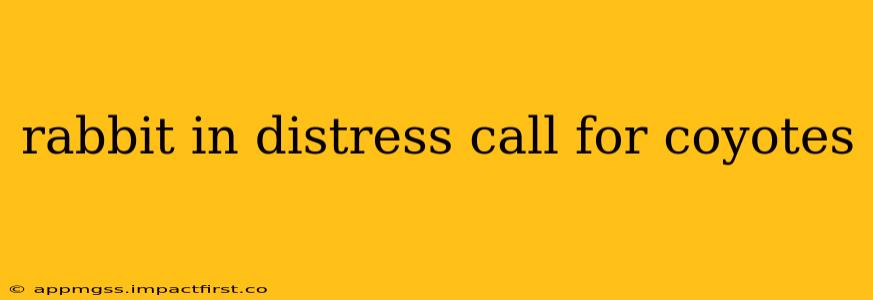Coyotes are highly adaptable predators found across North America, and rabbits represent a significant part of their diet. Understanding the sounds a rabbit makes when in distress, and how coyotes might respond, is crucial for both wildlife enthusiasts and those interested in predator-prey dynamics. This article delves into the complexities of rabbit distress calls and coyote vocalizations, exploring their significance in the wild.
What Sounds Do Rabbits Make When in Distress?
Rabbits don't have a single, easily identifiable "distress call." Their vocalizations are much more subtle and varied than those of many other animals. Instead of a loud scream or yelp, a rabbit in danger might exhibit:
- High-pitched squeals or screams: These are often short and sharp, emitted during a sudden attack or when cornered.
- Thumping: A rabbit will often forcefully thump its hind foot on the ground as a warning signal, potentially alerting others to danger or attempting to startle a predator. This isn't strictly a vocalization, but it's a key behavioral indicator of distress.
- Silence: Ironically, a sudden cessation of normal sounds, like rustling in bushes, can also be a sign that a rabbit is immobilized by fear or already captured.
It's important to note that the intensity and type of vocalization vary depending on the rabbit's species, age, and the severity of the threat.
What Sounds Do Coyotes Make When Hunting Rabbits?
Coyotes are skilled hunters, using a combination of stealth, speed, and vocalizations to locate and capture prey. The sounds they make during a rabbit hunt can include:
- Yips and barks: These shorter, higher-pitched calls are often used during tracking and pursuit, perhaps signaling to other pack members or coordinating the hunt.
- Howls: While less common during a hunt, coyotes may howl to communicate over longer distances, potentially marking territory or reinforcing pack cohesion.
- Growls and snarls: These lower-pitched sounds typically occur when a coyote has captured its prey or is engaged in a confrontation with another predator.
Coyotes are opportunistic and adapt their hunting strategies to the environment and the availability of prey.
Do Coyotes Use Rabbit Distress Calls to Hunt?
There's no evidence that coyotes actively use or understand rabbit distress calls to hunt more effectively. While coyotes are excellent listeners, their hunting relies more on keen senses of smell and hearing to locate prey, not specifically on interpreting the distress signals of their victims. Their primary hunting strategy involves stealth and ambush, with vocalizations primarily serving for communication within their pack or marking territory.
How Do Rabbits Escape Coyotes?
Rabbits employ various evasion techniques to escape coyote predation:
- Speed and agility: Rabbits are incredibly fast and agile, relying on sudden bursts of speed to outrun coyotes.
- Zigzag running: Their erratic running pattern makes it difficult for a coyote to maintain a straight chase.
- Hiding: Rabbits often seek refuge in burrows, dense vegetation, or rock crevices.
- Freezing: In some cases, a rabbit will "freeze" in place, hoping to remain undetected.
The success of these escape strategies depends largely on the rabbit's individual fitness, the surrounding environment, and the skill of the coyote.
What is the best way to help a rabbit in distress from a coyote?
Direct intervention is usually not recommended. Attempting to approach a coyote or intervene in a predator-prey interaction can be extremely dangerous, both for yourself and the animals involved. The best course of action is to observe from a safe distance and allow nature to take its course. However, reporting coyote activity near populated areas to your local wildlife authorities is always advisable.
This information aims to educate readers about the complex relationship between coyotes and rabbits. While we strive for accuracy, remember that wildlife behavior is unpredictable, and caution is paramount when observing predator-prey interactions.
